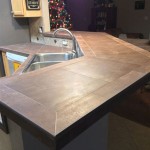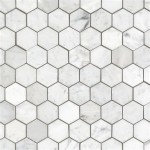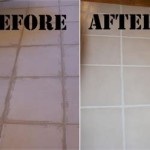How To Clean Dirty Bathroom Floor Tile Grout
Bathroom floor tile grout, a porous material found between tiles, is exceptionally susceptible to accumulating dirt, grime, mold, and mildew. Its recessed nature further exacerbates the problem, making routine cleaning essential to maintain a hygienic and aesthetically pleasing bathroom. Neglecting grout cleaning can lead to discoloration, stubborn stains, and potential health hazards. This article provides a comprehensive guide to effectively clean dirty bathroom floor tile grout, outlining various methods and preventative measures.
The accumulation of dirt and grime in grout lines is primarily due to the constant exposure to moisture, soap residue, body oils, and general bathroom debris. This creates a breeding ground for mold and mildew, which not only discolors the grout but can also emit unpleasant odors and pose health risks, particularly for individuals with respiratory sensitivities or allergies. Regular cleaning and maintenance are therefore crucial for preventing the buildup of these unwanted substances and maintaining a healthy bathroom environment.
Before commencing any grout cleaning method, proper preparation is essential. This involves gathering the necessary tools and supplies, as well as taking precautions to protect oneself and the surrounding surfaces. Common tools and supplies include: a stiff-bristled brush (a grout brush is ideal), a sponge, a bucket, rubber gloves, safety glasses, and the chosen cleaning solution.
Protecting oneself from potential splashes or fumes from cleaning solutions is of utmost importance. Rubber gloves protect the hands from harsh chemicals, while safety glasses shield the eyes. Ventilation is equally critical; opening a window or turning on the exhaust fan helps to dissipate any fumes and maintain good air quality. Furthermore, protecting surrounding surfaces such as walls and fixtures with drop cloths or plastic sheeting can prevent damage from accidental spills or splashes of cleaning solutions.
Key Point 1: Understanding Different Cleaning Methods
Several methods can be employed to clean dirty bathroom floor tile grout, each with its own advantages and disadvantages. The choice of method depends on the severity of the grout's condition, the type of tile, and personal preferences. These methods range from simple solutions using readily available household ingredients to more potent commercial cleaners.
A mild cleaning solution often proves sufficient for routine maintenance and lightly soiled grout. A mixture of warm water and dish soap or a diluted solution of white vinegar and water can effectively remove surface dirt and grime. This approach is gentle and environmentally friendly, making it suitable for regular cleaning without damaging the grout or tile. The solution is applied to the grout lines, allowed to dwell for a few minutes, and then scrubbed with a stiff-bristled brush before rinsing thoroughly with clean water.
For more stubborn stains and discoloration, baking soda and hydrogen peroxide can be used. This combination creates a mild abrasive paste that helps to lift dirt and lighten stains. Baking soda is a natural deodorizer and mild abrasive, while hydrogen peroxide acts as a bleaching agent. The paste is applied to the grout lines, allowed to sit for 5-10 minutes, and then scrubbed vigorously with a brush before rinsing thoroughly with clean water. This method is particularly effective for removing mildew and light mold stains.
Commercial grout cleaners offer a more potent solution for heavily soiled or stained grout. These cleaners typically contain stronger chemicals, such as bleach or chlorine, which can effectively remove stubborn stains and kill mold and mildew. However, it is essential to use these products with caution, following the manufacturer's instructions carefully and ensuring adequate ventilation. Always test the cleaner in an inconspicuous area first to ensure it does not damage the tile or grout. After application, the grout should be thoroughly rinsed to remove any residual chemicals.
Steam cleaning offers a chemical-free alternative for cleaning grout. A steam cleaner uses high-pressure steam to loosen dirt and grime, which can then be wiped away with a cloth. This method is particularly effective for removing embedded dirt and sanitizing the grout, killing mold and mildew without the use of harsh chemicals. Steam cleaning is also a good option for individuals with sensitivities to chemical cleaners. However, it is important to ensure that the steam cleaner is compatible with the type of tile and grout being cleaned and to avoid prolonged exposure of the steam to any one area to prevent potential damage.
Key Point 2: Step-by-Step Cleaning Procedures
Regardless of the chosen cleaning method, a consistent approach is crucial for achieving optimal results. The following step-by-step procedure outlines the general cleaning process, adaptable to different cleaning solutions and techniques.
The initial step involves removing any loose debris from the bathroom floor. This includes sweeping or vacuuming to remove dust, hair, and other particles that could interfere with the cleaning process. A thorough pre-cleaning ensures that the cleaning solution can directly target the grout lines without being hindered by surface debris.
Next, the selected cleaning solution is prepared according to the instructions provided. This may involve diluting a concentrated cleaner or mixing ingredients for a homemade solution. It is important to adhere to the recommended proportions to ensure the effectiveness of the cleaning solution without causing damage. The solution is then applied liberally to the grout lines, ensuring that the entire area is saturated. Allowing the solution to dwell for a predetermined amount of time, typically 5-10 minutes, allows it to penetrate the grout and loosen dirt and grime.
Using a stiff-bristled brush, vigorously scrub the grout lines in a back-and-forth motion. A grout brush, specifically designed for cleaning grout, is recommended for its narrow shape and durable bristles, which can effectively reach into the grout lines and remove embedded dirt. Focus on areas with visible stains or discoloration, applying extra pressure as needed. For larger floor areas, working in sections can help to maintain consistency and prevent the cleaning solution from drying out.
After scrubbing, thoroughly rinse the floor with clean water to remove all traces of the cleaning solution. This is a crucial step, as any remaining residue can attract dirt and grime, negating the cleaning efforts. Change the water frequently to ensure that the rinsing process is effective. A sponge or wet vacuum can be used to remove excess water from the floor.
Allow the floor to air dry completely. Proper drying prevents the regrowth of mold and mildew. Opening a window or turning on the exhaust fan can expedite the drying process. Avoid walking on the floor until it is completely dry to prevent tracking dirt or re-soiling the grout.
Key Point 3: Preventative Measures and Long-Term Maintenance
While cleaning is essential, implementing preventative measures can significantly reduce the frequency and intensity of grout cleaning. These measures focus on minimizing the accumulation of dirt and moisture, thereby inhibiting the growth of mold and mildew.
Regular sweeping or vacuuming of the bathroom floor is a simple yet effective way to remove loose dirt and debris before they become embedded in the grout lines. This should be done at least once a week, or more frequently in high-traffic bathrooms. Removing surface dirt prevents it from being ground into the grout by foot traffic and keeps the grout cleaner for longer.
After each shower or bath, wiping down the walls and floor with a clean, dry cloth helps to remove excess moisture and prevent mold and mildew growth. Pay particular attention to areas around the shower or bathtub, where moisture tends to accumulate. This simple habit can significantly reduce the likelihood of grout discoloration and the need for frequent cleaning.
Ensuring adequate ventilation in the bathroom is crucial for preventing the buildup of moisture. Utilize the exhaust fan during and after showers or baths to remove excess steam and humidity. If a bathroom lacks an exhaust fan, consider opening a window to improve air circulation. Proper ventilation helps to keep the grout dry, inhibiting the growth of mold and mildew.
Applying a grout sealant helps to protect the grout from stains and moisture penetration. Grout sealers create a barrier that prevents liquids and dirt from being absorbed into the porous grout, making it easier to clean and maintain. The sealant should be applied according to the manufacturer's instructions, typically after thoroughly cleaning and drying the grout. Reapply the sealant periodically, as recommended, to maintain its protective properties.
Using bath mats and rugs in high-traffic areas, such as in front of the sink and shower, can help to protect the floor tile and grout from dirt and moisture. These mats and rugs act as a barrier, trapping dirt and absorbing excess water before it reaches the grout. Regularly clean or replace the mats and rugs to prevent them from becoming a source of dirt and mildew.
By implementing these preventative measures and adopting a consistent cleaning routine, individuals can effectively maintain the cleanliness and appearance of their bathroom floor tile grout, ensuring a hygienic and aesthetically pleasing bathroom environment for years to come. Regular maintenance not only improves the appearance of the bathroom but also contributes to a healthier living space by preventing the growth of mold and mildew and minimizing the risk of respiratory problems and allergies.

How To Clean And Maintain Grout Tile Mountain

How To Clean Grout Tile Cleaning Tips Simply Spotless

How To Clean Grout Dirty In Five Minutes Without Using Bleach Express Co

How To Clean Dirty Unsealed Grout Slique

How To Clean Grout Cleaning Stains

How To Make Dirty Grout Look New Wildfire Interiors

3 Top Secret Tricks For Cleaning With Vinegar Making Lemonade

5 Grout Cleaning Tips From The Professionals Ser Luxury Shower Doors Inc

Aged And Dirty Bathroom Floor A Professional Grout Cleaning In Chicago Can Make It Look Like New Again

The Only Way We Got Our Stained Grout White Again Young House Love
Related Posts








